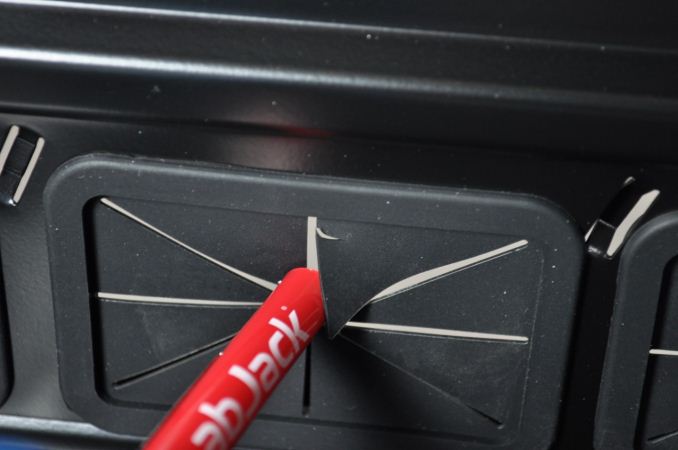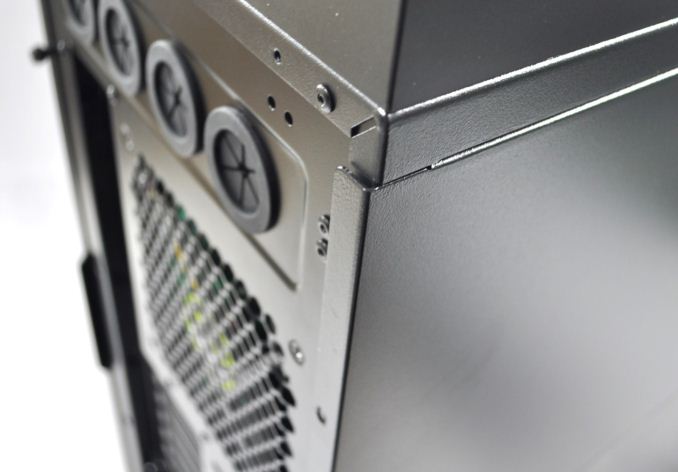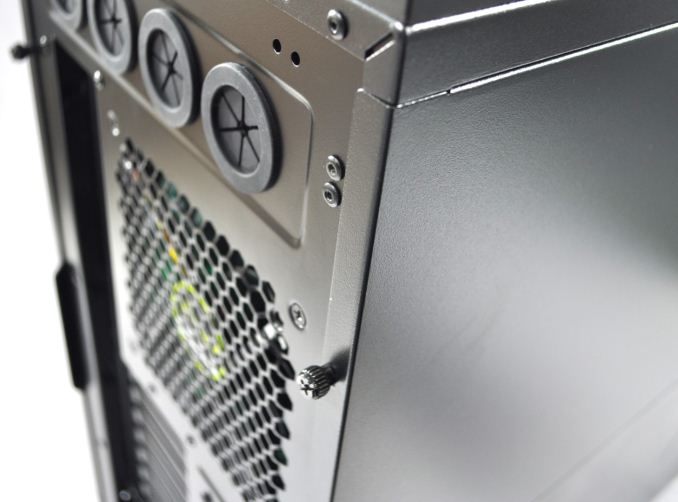Nanoxia Deep Silence 6 Review
by E. Fylladitakis on February 13, 2014 3:00 PM EST- Posted in
- Cases/Cooling/PSUs
- Full-Tower
- HPTX
- Nanoxia
- Case
With the Deep Silence 6, Nanoxia attempted to super-size their first design, the Deep Silence 1,turning it into a spacious, high performance behemoth. The end result is certainly very good, with the high quality a user would expect from Nanoxia and excellent thermal performance. As for space, the Deep Silence 6 has it in spades. Dual CPU and multi-GFX systems will easily fit inside this case, as will multiple liquid-cooling radiators. If desired, it would be possible to fit as many as five 1 × 140mm radiator liquid coolers in the Deep Silence 6 (one at the rear, two at the top, one at the front and one at the bottom of the case), enough for a dual CPU/triple GFX system.
Aesthetics are a subjective factor; while some (including the author) will love the clean, refined design of the Nanoxia Deep Silence 6, others will criticize it and most likely compare the appearnace with that of a refrigerator. Still, we would not go as far as to describe the design as "classic", as Nanoxia does. In fact, the organized lines and clean surfaces of the Deep Silence 6 are the very definition of a "minimalistic" design. A "classic design" and a "design classic" are two entirely different things and Nanoxia is most likely aiming for the latter. The only diminishing factor, if you purchase the version with the side panel window that is, is the second motherboard tray opening, which definitely is functional for users with dual CPU motherboards but will leave a large opening next to any ATX or smaller motherboard.
As with every product ever made, the Nanoxia Deep Silence 6 is not perfect. The most obvious flaw with this case is the massive weight, which will likely result in many of its users looking for gym registrations. Even when empty, the case is almost impossible to handle by anyone without some upper body strength. A set of wheels to replace the feet of the case would be more than a welcome addition, or even selling these as an optional extra. A second minor complaint would be the quality of the rubber grommets around the motherboard tray; they did feel flimsy, so we decided to stress test one by forcefully moving back and forth a bunch of cables through the hole. Soon afterwards, it started cracking. The vast majority of users will never notice such a problem but those who frequently upgrade their systems (or are clumsy at doing so) are likely to end up with a damaged grommet or two.
Super-sizing an existing design can also have significant side effects on the mechanical cohesion of, well, everything. The Deep Silence 6 is no exception; the chassis of the case is exceptionally sturdy and this is why the case is so heavy as well, yet this approach backfires because this chassis bases its structural integrity solely on the metallic frame and the side panels, without any serious support between the four main exterior panels of the chassis. While this probably worked fine with their smaller designs, elongating all of the main panels and doubling the weight of the case weakens the mechanical strength of the design significantly.
As a result, once the side panels are removed, the (empty) chassis frame twists by quite a few minutes, perhaps even over a degree, on its own. This is apparent when installing/removing the side panels, which will not align with the main body of the case until they're screwed in tightly. This is far from a major problem, and the Deep Silence 6 is certainly strong enough to withstand a lot of punishment, yet it is easily noticeable and gives the feeling of a bad mechanical design. On the other hand, extra supports would not only reduce the interior functionality of the case but would probably restrict certain features, such as the front liquid cooling radiator bracket, and they would also increase the weight of an already ridiculously heavy case even further.
Overall, Nanoxia did a great job with the Deep Silence 6, even though it is essentially is a super-sized Deep Silence 1 with added features. It is well made, the design is attractive, it is ludicrously spacious, and it's very versatile. Priced at 199 EUR and currently available for $230 USD or in white for the same price -- though neither option is widely available in the US at present — the Deep Silence 6 is rather competitively priced, steering clear of the price range of other monstrous contraptions like the Corsair 900D and the Cooler Master Cosmos II.
Still, a case of such size and pricing is far from mainstream and has a very specific target audience, which is small and often very demanding. If you're part of that target audience, the DS6 may be precisely what you're looking for. The DS6 does well, and while it's not a clear winner in every respect it also manages to avoid having any serious flaws. If you have the desire (and the requisite muscles) for this sort of case, it's certainly worth a look.













26 Comments
View All Comments
c4v3man - Thursday, February 13, 2014 - link
One other thing to note, on the white case at least, the difference between the white plastic and the white painted steel is noticeable... not terrible, but when it sits on your desk awhile, you'll notice it.codylee - Thursday, February 13, 2014 - link
Huge. The picture with the full ATX board looking like it's a mITX board made me double-take. I'm looking forward to a review of the DS4 (a case I could actually pick up and move if need be).The_Assimilator - Friday, February 14, 2014 - link
Whoever copy edited this article (or didn't) did an atrocious job. First page, "four different cooling fans series" and "where the only option as to import their products" and it only goes downhill from there.Get your s**t together, AnandTech.
dawp - Friday, February 14, 2014 - link
Nanoxia is a bit older than two years, I have some of their FX 1250 fans I've had for longer than you say the company's been around.http://www.performance-pcs.com/catalog/index.php?m...
maybe you should say they've been making cases for 2 years.
Aslan7 - Saturday, February 15, 2014 - link
E. Fylladitakis Would you please do temperature testing with the chimney closed? I'd trade cooling performance for the quiet. I prefer computers to run as quietly as possible and thus run as few fans as possible.One of my computers has a power supply fan and CPU fan and that's it the 7950 GTX with a stock oc is passively cooled. The second computer which is a current build has a core i7 3770K at 4.3GHZ 4 hard disks and a graphics card there's an intake fan on the hard disks, a single fan on the CPU, the cooler had two I removed 1, a fan on the GPU, and the power supply fan. All the fans are running slow, everything is temperature controlled, so nothing to worry about.
Haravikk - Monday, February 24, 2014 - link
It's an interesting case, but the noise levels are pretty disappointing for a case of this name. I now swear by Prolimatech Ultra Sleek Vortex 14's for both CPU coolers and case-fans; 15mm thick 140mm fans that fit 120mm fan mounts, but they are very quiet for the amount of air they push. Not quite as silent as I'd like, but a fan mechanical noise can be cancelled with a layer of acoustic foam on the inside of your case, particularly the side panel on the main access side.But yeah, there are definitely things that could be done to make this case a lot quieter, and which you could probably do to a more typical non "Silence" case with pretty much the same effect. The only feature that really stands out to me is the disk trays with rubber spacers, but then you can get these in many other cases too, or you can get a case with tons of 5.25" bays and install your own noise cancelation there, though of course it's more expensive that way.